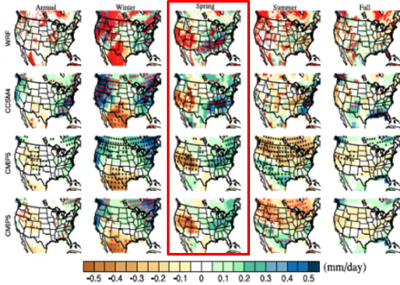Water Woes Projected in U.S. Southwest: Regional water availability reductions ahead according to research that reveals spring drying trends
New research from scientists at Pacific Northwest National Laboratory identified a trajectory of spring drying that will alter water availability across the U.S. Southwest. To describe the net change in water, they calculated the water gained through precipitation and subtracted the water lost through evaporation and transpiration in an ensemble of regional and global simulations. Their findings indicate future challenges for regional water resource managers and agricultural production.
“Our research identified a prominent spring drying trend over the U.S. Southwest and a seasonal migration of the wet and dry patterns,” said Dr. Yang Gao, post-doctoral researcher and atmospheric scientist at PNNL. “These signals are strong and consistent across regional and global climate projections.”
The PNNL research team calculated changes in water availability from a multi-model ensemble of climate simulations for the present (1975 – 2004) and the future (2070 – 2099) produced by a single regional climate model and 20 global climate models used in the Intergovernmental Panel on Climate Change (IPCC) Fifth Assessment Report (AR5). Through both model agreement and statistical significance they identified robust changes across the models. They investigated the relationships between seasonal large-scale circulation and water availability changes using regression analysis to evaluate the contributions of dynamical changes, in addition to increased moisture availability, to changes in precipitation minus evapotranspiration (P-E). Lastly, they depicted seasonal P-E changes by the seasonal timing of the dominant wet/dry trends derived from the regional and global model projections to highlight their robust features over North America.
Their research shows that seasonal changes in the large-scale circulation and increased atmospheric moisture due to warmer temperatures lead to wet/dry trends that are dominated by two distinct and opposite north-south and east-west patterns.
Water in the soil, streams, and groundwater is critical for Earth ecosystems and food and energy production, so understanding and projecting how water availability is going to change in the future is a major science challenge with important societal implications. While global precipitation is projected to increase in a warmer climate, water availability is a measure determined by regional precipitation and the amount of moisture that either evaporates or is taken up by plants, called transpiration. Together, precipitation and evapotranspiration vary greatly over a region, and their changes are due to complex alterations in atmospheric circulation, soil moisture, and many other processes. The new research underscores the importance of evaluating changes in regional North American water availability and propels efforts to evaluate their implications for climate impacts and adaptation.
“Increasing greenhouse gases cause the atmosphere to hold more moisture in a warmer climate, intensifying Earth’s water cycle,” said Dr. Ruby Leung, PNNL Laboratory Fellow, atmospheric scientist and corresponding author on the study. “Changes in the water cycle have significant implications for water availability that challenge regional resilience to climate change.”
As the earth system responds to increasing greenhouse gases, the water cycle is projected to intensify in a warmer climate that holds more moisture in the atmosphere. Regional changes in the water cycle can have significant implications to water availability that challenge societal resilience to climate change. A team of Department of Energy scientists at Pacific Northwest National Laboratory compared climate simulations over North America produced by a regional climate model to investigate robust changes in water availability. They analyzed precipitation minus evapotranspiration (P-E) changes for the future (2070-2099) compared to the present (1975-2004) across the multi-model ensemble. The team found that although models do not always agree on P-E changes in different seasons or regions, a robust spring drying signal is identified in the Southwest across the multi-model ensemble that results from a decrease in P and an increase in E in the future. The progression of the north-south and east-west dipole patterns through the seasons manifests clearly as a seasonal “clockwise” migration of wet/dry patterns, which is associated with thermodynamical as well as large-scale circulation changes. This study identified two robust features of water availability changes in North America that are consistent across regional and global climate simulations: drying over the Southwest in spring and seasonal migration of wet/dry patterns. These changes have important implications for water resources management and agricultural in the future.
The U.S. Department of Energy Biological and Environmental Research supported this research as part of the Regional and Global Climate Modeling Program and Integrated Assessment Research Program. The regional climate simulations used in the analysis received support from the PNNL Platform for Regional Integrated Modeling and Analysis (PRIMA) initiative, a PNNL Laboratory Directed Research and Development program.

